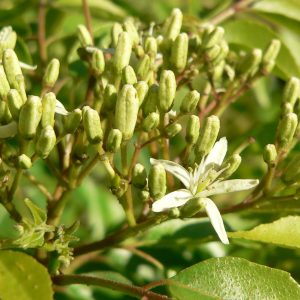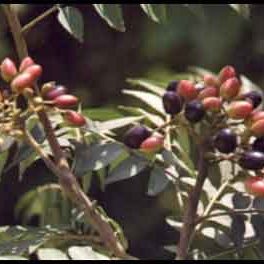Murraya koenigii
Curry leaf
Origin
Native of India, Sri Lanka and other south Asian countries.
Climate
Sub-tropical and up to 1500m in the tropics. They will grow in cool climates but may go dormant or semi-dormant during cold weather.
Plant Description
A semi-deciduous ornamental shrub or small tree, 3-5m tall, with a dense canopy. The alternate compound imparipinnate glabrous and very aromatic leaves are 15-20cm long with 9-20 ovate–lanceolate leaflets, 2.5-3.5cm long.
Relatives
Rutaceae Family. Related to citrus, white sapote and wampi.
Soils
Moist but well-drained fertile soil is preferred.
Propagation
Seeds, root suckers and cuttings (difficult). Seeds must be fresh for sowing; those from dried or shrivelled fruits are not viable.
Cultivars
None.
Flowering and Pollination
Inflorescences are terminally borne cymes with 40-60 individual white funnel-shaped sweetly-scented bisexual flowers, 1cm diameter, each with a green 5-lobed calyx, 5 white petals, 2 circles of 5 stamens, a sticky stigma on a short style and a superior ovary.
Cultivation
It will grow in full sun or partial shade and is tender when young. A slow grower from seed. Once established, it should be fertilized in the same way as citrus. Citrus plants have been successfully grafted onto Murraya rootstock. They can be grown in large pots.
Wind Tolerance
Might need some protection from strong winds.
Pruning
There is little advantage in letting it get too big, so keep it pruned to a low, accessible bush.
The Fruit
These are ovoid to sub-globose, about 1.5cm long, with shiny purplish-black skin when ripe, and 1, less commonly 2, green seeds 5-7mm long. Fruit are high in antioxidants with good levels of anthocyanins. The edible portion of fresh fruit is 50% and contains 10% sugars. The seeds are poisonous.
Fruit Production and Harvesting
Once established, these plants are relatively low maintenance. They are grown mainly for their leaves which can be picked whenever needed.
Fruit Uses
The aromatic leaves, a very important ingredient in Indian cuisine, are used as flavouring and seasoning ingredients in many prepared foods. They are used raw or dried, but can also be frozen, fried or toasted and crumbled. The dried powdered leaves represent a convenient storage form as little flavour is lost. With cooking of whole fresh leaves, they may be either incorporated or removed from the resulting prepared food. The fruits may also be eaten, but do not eat the seeds.
Pests and Diseases
Minimal.
Comments
Plants self-seed prolifically, and the roots spread widely and sucker, creating new trees. They are very invasive and so need to be kept under control by removing seedlings and keeping the sucker growth down.

